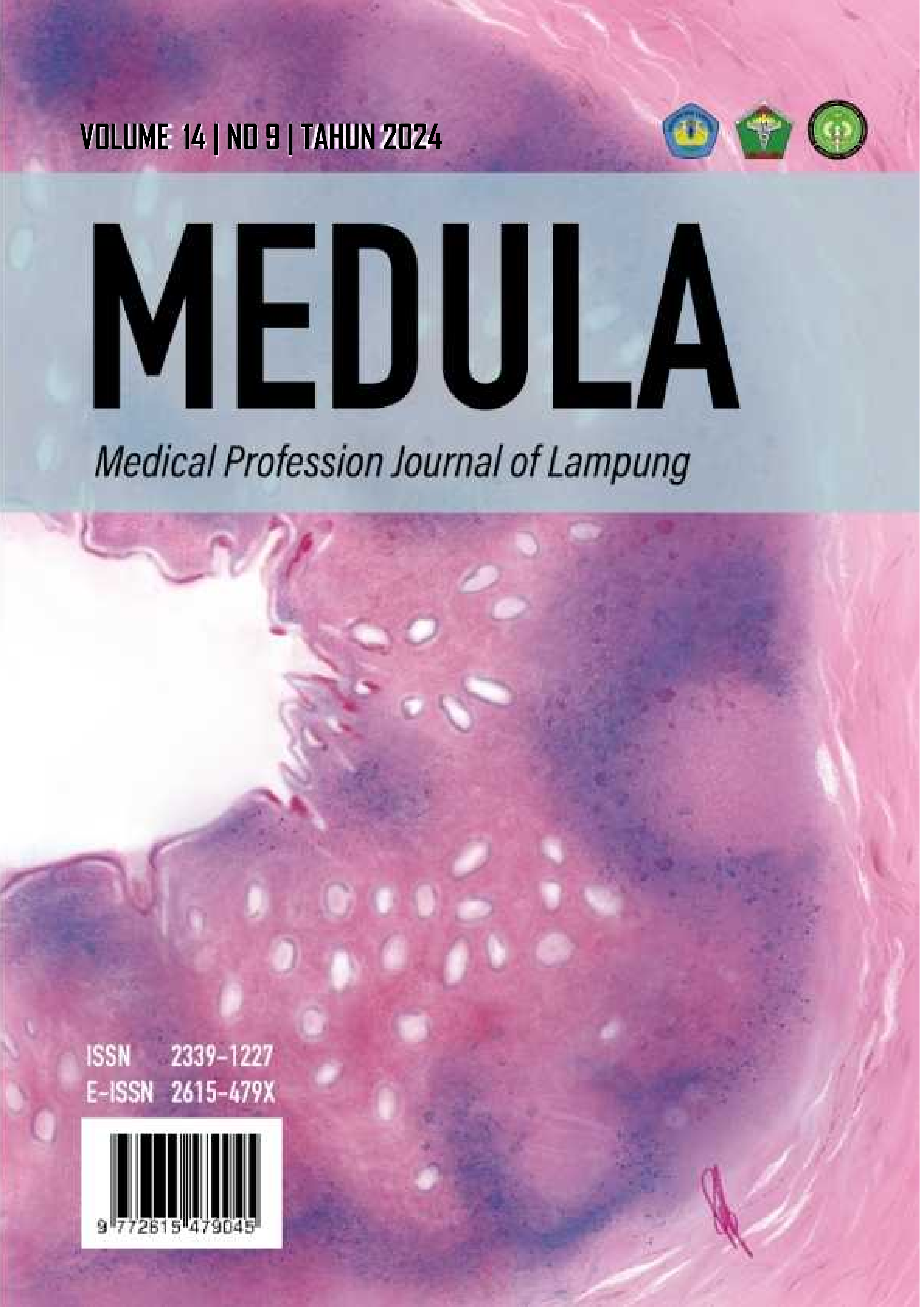Relationship Between Monocyte Lymphocyte Ratio (RML) and Left Ventricular Ejection Fraction on Heart Failure Patients
DOI:
https://doi.org/10.53089/medula.v14i9.1339Keywords:
heart failure, left ventricular ejection fraction, LMR, LVEFAbstract
In the pathogenesis of heart failure, there is an inflammatory process that has a close relationship, where both influence each other. The lymphocyte monocyte ratio (LMR) is a cheap and easy inflammatory biomarker and is considered to function as a predictor of poor clinical outcomes in heart failure patients. This study is an analytical descriptive study conducted with a cross-sectional design. The sampling technique was carried out using consecutive sampling techniques from samples that met the inclusion and exclusion criteria. In this study, a chi-square test was carried out to test for significant relationships between variables. Researchers used secondary data from 86 medical record data. A total of 23.26% of samples had low LMR (≤2) with low ejection fraction (≤40%) and 3.49% had low LMR (≤2) and high left ventricular ejection fraction (>40%). On the other hand, there were 44.18% of samples that had high RLM (>2) with low left ventricular ejection fraction (≤40%) and there were 29.07% of samples that had high RML (>40%) and low left ventricular ejection fraction (≤2). The results of the chi-square test stated that the p value of both variables was 0.02 with an odds ratio of 4.386. Therefore, it can be concluded that there is a significant relationship between the lymphocyte monocyte ratio (LMR) and left ventricular ejection fraction in heart failure patients at Dr. H. Abdul Moeloek Hospital, Lampung Province in 2023.
References
Savarese G, Becher PM, Lund LH, Seferovic P, Rosano GMC, Coats AJS. Global burden of heart failure: a comprehensive and updated review of epidemiology. Cardiovasc Res. 2022;118(17):3272-87. doi:10.1093/cvr/cvac013.
Groenewegen A, Rutten FH, Mosterd A, Hoes AW. Epidemiology of heart failure. Eur J Heart Fail. 2020;22(8):1342-56. doi:10.1002/ejhf.1858.
Emmons-Bell S, Johnson C, Roth G. Prevalence, incidence and survival of heart failure: a systematic review. Heart. 2022;108(17):1351-60. doi:10.1136/heartjnl-2021-320131.
European Society of Cardiology. The ESC Textbook of Heart Failure. 2023.
Becher PM, Lund LH, Coats AJS, Savarese G. An update on global epidemiology in heart failure. Eur Heart J. 2022;43(32):3005-7. doi:10.1093/eurheartj/ehac248.
Delcea C, Buzea CA, Dan GA. The neutrophil to lymphocyte ratio in heart failure: a comprehensive review. Rom J Intern Med. 2019;57(4):296-314. doi:10.2478/rjim-2019-0018.
Delcea C, Buzea CA, Dobrev D, Dan GA. Prognostic roles of neutrophil–lymphocyte, monocyte-lymphocyte and platelet-lymphocyte ratios for long-term all-cause mortality in heart failure. IJC Heart Vasc. 2024;54:101502. doi:10.1016/j.ijcha.2024.101502.
Silva N, Bettencourt P, Guimarães JT. The lymphocyte-to-monocyte ratio: An added value for death prediction in heart failure. Nutr Metab Cardiovasc Dis. 2015;25(11):1033-40. doi:10.1016/j.numecd.2015.07.004.
Delcea C, Buzea A, Dima A, Tocitu A, Andrus A, Breha A. The Lymphocyte-To-Monocyte Ratio - A Novel Independent Predictor Of All-Cause Mortality In Patients. 2018. [Catatan: Informasi jurnal tidak lengkap].
Aono T, et al. Lymphocyte-to-monocyte ratio could predict adverse clinical outcomes in patients with heart failure with preserved ejection fraction. Eur Heart J. 2019;40(Suppl 1):5950. doi:10.1093/eurheartj/ehz746.0100.
Deek H, Massouh A, Davidson PM. Heart Failure in Lebanon: A Review of the Literature. J Keperawatan Indones. 2022;25(1):17-31. doi:10.7454/jki.v25i1.1796.
Felker GM, Mann DL. Heart Failure: A Companion to Braunwald’s Heart Disease. 4th ed. 2020.
Lippi G, Sanchis-Gomar F. Global epidemiology and future trends of heart failure. AME Med J. 2020;5:2-7. doi:10.21037/amj.2020.03.03.
Kato M. What is Heart Failure? J Nihon Univ Med Assoc. 2015;74(4):153-60. doi:10.4264/numa.74.153.
Yang F, et al. Clinical prognostic impact of C-NLR in heart failure patients with different ejection fractions: a retrospective study. BMC Cardiovasc Disord. 2024;24:56. doi:10.1186/s12872-024-03714-4.
Inamdar AA, Inamdar AC. Heart failure: Diagnosis, management and utilization. J Clin Med. 2016;5(7):62. doi:10.3390/jcm5070062.
Gong S, et al. Association of lymphocyte to monocyte ratio with severity of coronary artery disease. Medicine (Baltimore). 2018;97(43):e12813 . doi:10.1097/MD.0000000000012813.
Vakhshoori M, et al. Prognostic impact of monocyte-to-lymphocyte ratio in coronary heart disease: a systematic review and meta-analysis. J Int Med Res. 2023;51(10):03000605231204469. doi:10.1177/03000605231204469.
Gijsberts CM, et al. Effect of Monocyte-to-Lymphocyte Ratio on Heart Failure Characteristics and Hospitalizations in a Coronary Angiography Cohort. Am J Cardiol. 2017;120(6):911-6. doi:10.1016/j.amjcard.2017.06.020.
Downloads
Published
How to Cite
Issue
Section
License
Copyright (c) 2025 Medical Profession Journal of Lampung

This work is licensed under a Creative Commons Attribution-ShareAlike 4.0 International License.














